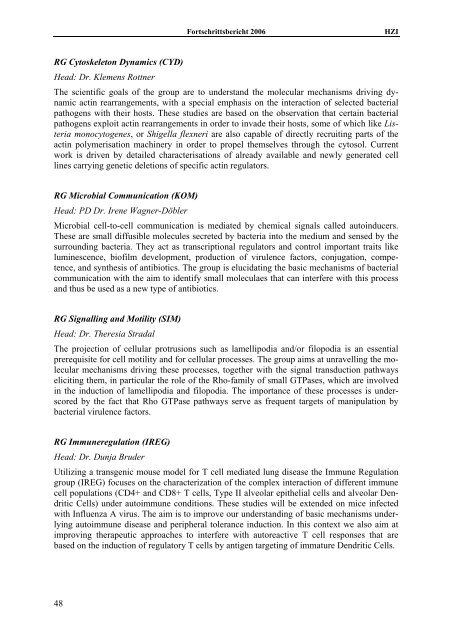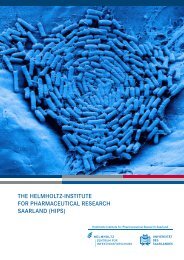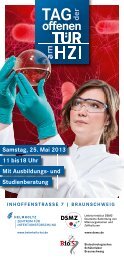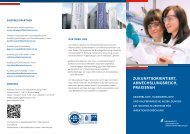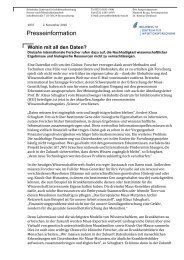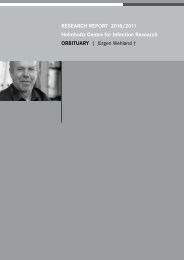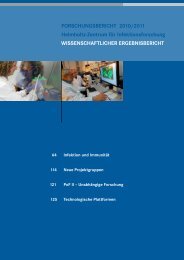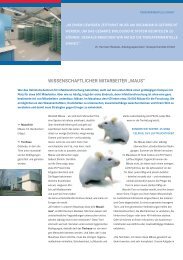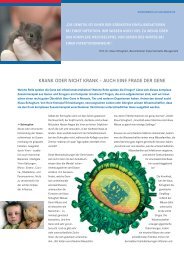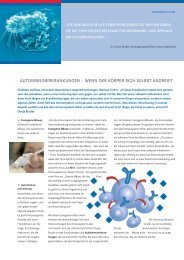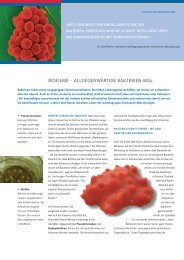FORTSCHRITTSBERICHT JAHR 2006 - Helmholtz-Zentrum für ...
FORTSCHRITTSBERICHT JAHR 2006 - Helmholtz-Zentrum für ...
FORTSCHRITTSBERICHT JAHR 2006 - Helmholtz-Zentrum für ...
Sie wollen auch ein ePaper? Erhöhen Sie die Reichweite Ihrer Titel.
YUMPU macht aus Druck-PDFs automatisch weboptimierte ePaper, die Google liebt.
48<br />
Fortschrittsbericht <strong>2006</strong> HZI<br />
RG Cytoskeleton Dynamics (CYD)<br />
Head: Dr. Klemens Rottner<br />
The scientific goals of the group are to understand the molecular mechanisms driving dynamic<br />
actin rearrangements, with a special emphasis on the interaction of selected bacterial<br />
pathogens with their hosts. These studies are based on the observation that certain bacterial<br />
pathogens exploit actin rearrangements in order to invade their hosts, some of which like Listeria<br />
monocytogenes, or Shigella flexneri are also capable of directly recruiting parts of the<br />
actin polymerisation machinery in order to propel themselves through the cytosol. Current<br />
work is driven by detailed characterisations of already available and newly generated cell<br />
lines carrying genetic deletions of specific actin regulators.<br />
RG Microbial Communication (KOM)<br />
Head: PD Dr. Irene Wagner-Döbler<br />
Microbial cell-to-cell communication is mediated by chemical signals called autoinducers.<br />
These are small diffusible molecules secreted by bacteria into the medium and sensed by the<br />
surrounding bacteria. They act as transcriptional regulators and control important traits like<br />
luminescence, biofilm development, production of virulence factors, conjugation, competence,<br />
and synthesis of antibiotics. The group is elucidating the basic mechanisms of bacterial<br />
communication with the aim to identify small moleculaes that can interfere with this process<br />
and thus be used as a new type of antibiotics.<br />
RG Signalling and Motility (SIM)<br />
Head: Dr. Theresia Stradal<br />
The projection of cellular protrusions such as lamellipodia and/or filopodia is an essential<br />
prerequisite for cell motility and for cellular processes. The group aims at unravelling the molecular<br />
mechanisms driving these processes, together with the signal transduction pathways<br />
eliciting them, in particular the role of the Rho-family of small GTPases, which are involved<br />
in the induction of lamellipodia and filopodia. The importance of these processes is underscored<br />
by the fact that Rho GTPase pathways serve as frequent targets of manipulation by<br />
bacterial virulence factors.<br />
RG Immuneregulation (IREG)<br />
Head: Dr. Dunja Bruder<br />
Utilizing a transgenic mouse model for T cell mediated lung disease the Immune Regulation<br />
group (IREG) focuses on the characterization of the complex interaction of different immune<br />
cell populations (CD4+ and CD8+ T cells, Type II alveolar epithelial cells and alveolar Dendritic<br />
Cells) under autoimmune conditions. These studies will be extended on mice infected<br />
with Influenza A virus. The aim is to improve our understanding of basic mechanisms underlying<br />
autoimmune disease and peripheral tolerance induction. In this context we also aim at<br />
improving therapeutic approaches to interfere with autoreactive T cell responses that are<br />
based on the induction of regulatory T cells by antigen targeting of immature Dendritic Cells.


